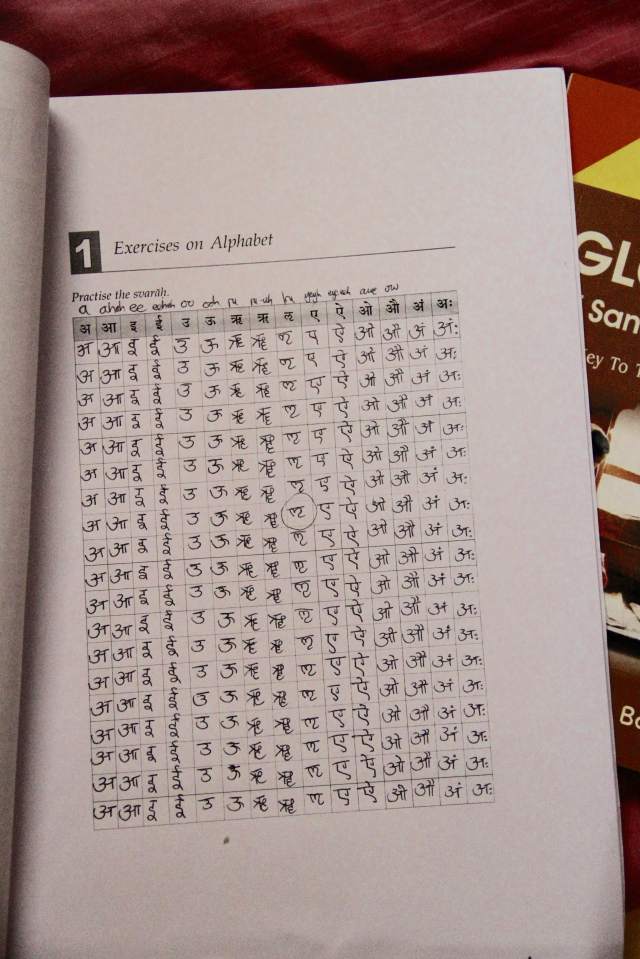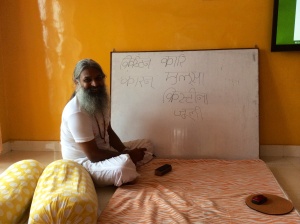Bhakti Chanting, Sanskrit and Mythology
 Out of the mountain of our yoga teacher training study materials, I was immediately drawn to the chanting books; Bhakti or devotional chanting, which I love. We sing the invocation to Patanjali every day, and it’s nice to begin asanas with this familiar chant that I know well from many Iyengar yoga classes back home.
Out of the mountain of our yoga teacher training study materials, I was immediately drawn to the chanting books; Bhakti or devotional chanting, which I love. We sing the invocation to Patanjali every day, and it’s nice to begin asanas with this familiar chant that I know well from many Iyengar yoga classes back home.
For the first week, we have an hour of chanting in the morning, sometimes accompanied by the beat of tabla drums. Our voices are all a bit rusty and querulous to begin with as we get used to the melodies, but Yogi Sivadas‘ rich, deep voice fills the sunny room and we soon let go of our shyness or self judgment as we join in with the ancient chants.
Repeated chanting improves concentration and is extremely calming, physically and mentally, as your brain focuses only on the words and the tune. Devotional chanting to the deities (and it doesn’t matter which religion or belief system you have; they’re all here, including Buddha, Moses, Jesus, Jehovah, Allah, Shiva, Ganesh, and more), when sung with intention, can create a peaceful mind. I took my blood pressure before this morning’s chanting: 199/97 with a pulse rate of 69. After an hour of chanting: 129/80 and pulse of 59.
Slightly less calming (i.e. challenging!) are our Sanskrit lessons. “Sanskrit” means well written, or purely written, and is an Indo-Persian tree of language that evolved around 30,000 years ago. We start to learn the basics of the sounds and letters – who knew there were so many ways to pronounce the sounds ‘s’ and ‘sh’! We practice lines and lines of squiggles and dots, repeating them out loud as we write.
Yogi Sivadas writes our names on the board in Sanskrit and they look so pretty, it encourages us to keep on squiggling. He tells us that even if we find it difficult, the very act of focusing your mind on something new in an attempt to learn something, is good exercise for the brain, and you will benefit from that, regardless of the results of the studying. And when he tells us that the Sanskrit word, “cittrashalabh” translates as “insect painting” or “insect art”, doesn’t that sound much more beautiful and poetic than the English word, butterfly?
Our daily studies are peppered with colourful analogies, as Yogi Sivadas explains some yoga philosophy concepts through yoga mythology and allegories. I am constantly reminded of how rich and mystical this culture is, making our own Cinderella and Sleeping Beauty seem dull, by comparison!





Awesome post! I’m taking a Sanskrit class at uni, it’s a very rewarding language. Keep up the good work! Great post by the way!
Thank you! How wonderful that you’re studying Sanskrit – challenging, fascinating and rewarding!
I just finished a yoga session with you and have now spent the rest of the day reading your blogs It’s been a magical day with you..Thank you for being in my life and starting the new year off in such an awesome way (oops there’s that overused word). But it’s true this time..
Aaaaahhh. My New Year begins with a yogini who loves and appreciates life, is truly grateful for every day, AND brings a smile to my heart. Couldn’t ask for more. Thank you for being a joyful part of my yoga adventure.
[…] Yoga into five essentials. Yes, we studied yoga philosophy and yoga psychology and Vedic wisdom and ancient Sanskrit and sequencing of yoga asanas – all of it fascinating and interesting and rewarding. And all of […]